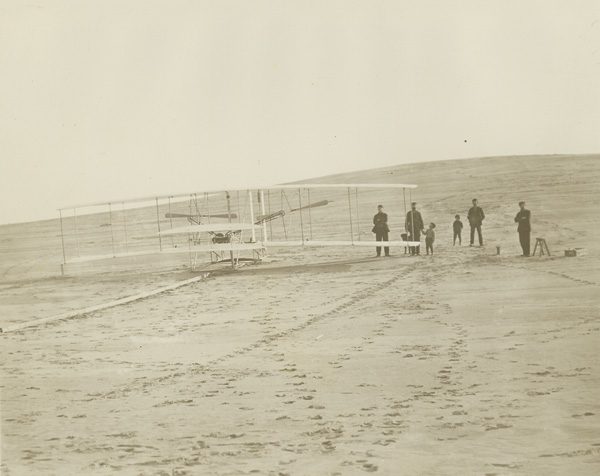
Trial and Preparation. Orville returned from Dayton with the repaired propeller shafts on Dec. 11th. It only took a day to finish the assembly of the Flyer. There were no winds but they used their time wisely running the Flyer up and down the track checking speed but damaging the tailframe. More repairs.
Dec. 13th failed to deliver winds for a flight but it was also a Sunday and the sons of Bishop Wright had kept their promise to not do aviation work on the sabbath. Monday, Dec. 14th, there was no wind sufficient for a flight but Wilbur and Orville went back to work repairing the tailframe and starting the “truck”.
1:30 pm: They put out the signal, a large red flag on the side of the hangar, to the lifesaving station that they needed help. Bob Wescott, John T. Daniels, Tom Beacham, Will Dough, and “Uncle Benny” O’Neal along with two young boys arrived shortly.
As there was no wind they decided to move their “runway” 60 ft of 2×4’s with a metal strip to the lower section of Big Kill Devil Hill, a 9 degree slope, up 150 ft. This was ¼ mile from their hangar, requiring much effort and 40 minutes of grit and muscle. Then, they carried the 605 lb Flyer to the rail on the slope.
2:40 pm the machine was on the rail restrained. The engine was fired up and its clatter and vibrations scared the two little boys to a run.
As the engine was warming up, Wilbur and Orville stepped aside to themselves, flipped a coin. Wilbur won the coin toss.
Wilbur climbed aboard into position. Orville went to the right wingtip. Wilbur looked right and left, flipped the clip holding the restraining rope. Nothing! The machine’s weight and gravity exerted too much pressure on the release clip. Orv and three of the lifesaving station members pushed the Flyer a few inches back up the slope to create slack. (This is 4 men pushing a 605 lb aircraft and 150-155 lb man up the hill).
Off he went before everyone was ready and in place. Orville had to catch up and grab the wingtip as best as possible. He could not keep up. The Flyer rose into the air, but nosed sharply at low altitude, 15 ft-too much of an angle of attack, it slowed, stopped, and fell to the ground approximately 60 ft from the end of the rail-and another 40 ft from where it lifted off from the rail. Time, 3.5 seconds.
“The left wingtip struck first, swinging the craft around until the front skids hit the soft sand hard enough to splinter one of the elevator supports.”
Stunned but alright, Wilbur took a few moments then shut down the engine. Trial one, done.
This test showed that the Flyer was working as designed and expected, but with a little more sensitivity in operation.
It had been a long time since arriving late September, and finally they saw that the Flyer would indeed fly.
This was a test. Wilbur and Orville well understood that this test could not stand as the gravity provided assistance. The test to rise from the ground under its own power would be a few days more.
Historical context, The Bishop’s Boys, Dr. Tom Crouch

